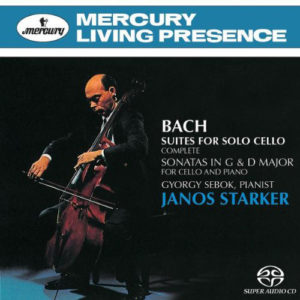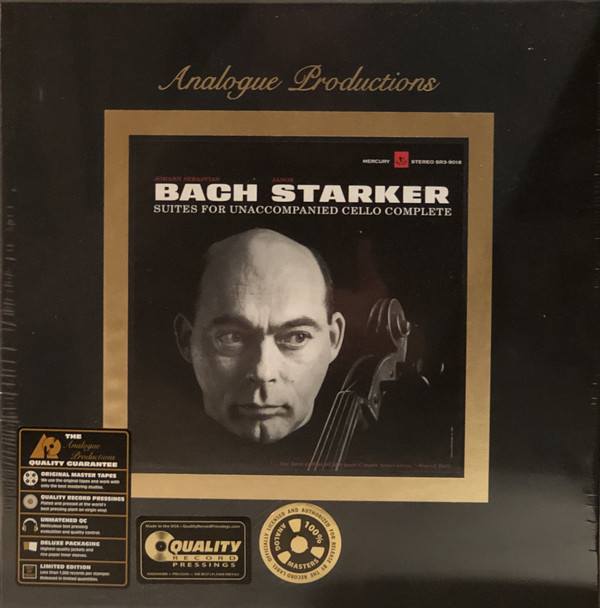
Janos Starker.
Janos Starker. Bach Suites for solo cello complete. Mercury Living Presence.
470644-2 SACD direct to DSD 3 channel stereo ,DSD stereo & CD published 2004.
Recorded 1963-1965 at Ballroom studio A Fine recording New York.
Original recording re released on CD 1991.
General comments of the recording.
Firstly, be very clear that this is not a state of the art high fidelity recording, with the original dating from the 60s.
I have not as yet compared this 2004 version with the vinyl or original CD versions, but Mercury are at pains to emphasise the care taken in this re mastering. In addition, the enhancements brought about by direct to DSD conversion. I was listening using the standard CD mix.
The Recording.
There is little in the way of hiss, distortion or flutter which sometimes accompanies older recordings. However, I would describe the sound as a little compressed. The cello in the higher registers sounds a bit nasal and sometimes brassy. Bass notes are fulsome. The thought occurs to me that overall the sound is a bit like listening to the artist in a tunnel!
Listening to the Bach Cello Sonatas also included on this 2 CD set, I was immediately aware of a much more pleasant cello sound from similar aged recordings. It may be that the CD and SACD were produced from different sources. I am not an expert in the technology of digital re mastering but I am aware that advances are not without penalties in some cases.
The Music.
Janos Starker is of course a very respected virtuoso at his peak in the 60s and 70s. He plays with a very full bold tone. The style in this recording is to play smoothly but well articulated with largely separate bowing. This seems to be in contrast to his earlier recordings from the 50s when he tended to play with notes more grouped into single long bows. I get the impression that every note is carefully considered and precisely placed. There is almost a surgical precision but there is emotion communicated. Likewise, with light and shade and different tone according to the movement played. Some slower sections sound quite mellifluous, with other faster sections sounding almost harsh in the amount of vigour applied. Some of the gigues sound like a fencing duel!
To Dance or not to Dance.
My main thoughts about these performances are that the dance nature of the non prelude movements is not conveyed particularly well. Starker plays as if the music is a song but the bounce and rhythm needed to convey a dance is not there that I can detect.
A specific observation that I would make is of the Prelude from the 4thSuite. The style of play here seems to be to emphasise the second quaver of each bar in the opening passages which gives the music an almost crab like gait feel. I mention this not to be disrespectful but to highlight my overall reservations about the rhythm and style of these performances.
In the notes Starker himself is quoted as saying,” Any attempt to classify a performance of this work as a truly Bach presentation is futile and baseless. The equipment of the contemporaneous cello is quite different from that of those used in Bach’s time. The very fact that these works are performed today in a concert hall makes necessary completely different solutions.” Clearly Starker opts to fill the concert hall with bold strident and exciting sounds!
Summary.
In summary, imagine if the period between the present and the composition of the Suites were considered as a time line. Then Starker’s performances could be considered as an important staging post on that time line. However, in my opinion, there are other versions for those seeking a definitive version for the here and now.
NB Starker has recorded five versions of the Suites. It can be very difficult to determine which recording is being purchased due to numerous re issues with different packaging. My research indicates that Starker recorded firstly, four of Bach’s Cello Suites in the late 1950s for Period (reissued on Nixa and Saga). Theron, between 1956 and 1992, four complete cycles, for EMI/Columbia, Mercury, Seffel and RCA. It is most regrettable in my view that record labels very rarely make it clear on the external packaging when a performance was originally recorded.
Charles.
Janos Starker from box set 4786754.
History.
Janos Starker recorded multiple versions of the suites throughout his career. However, it seems to be the accepted wisdom that his Mercury set and a much later RCA set (which will be reviewed separately) are the two best known. To further complicate matters though, the Mercury set has been issued in vinyl, cd, and a bells and whistles sacd version too. I wouldn’t mention this, except for the fact that in this case forums suggest there may be significant differences in the recordings quality. My cd version is from a 2014 set (reissued under Decca’s auspices) of Starker’s complete Mercury Living Presence recordings. There is no evidence though that this cd version is any different from any earlier Mercury cd release of the suites.
The Recording.
Turning to the recording quality itself life gets interesting. Mercury were highly renowned for their early stereo era recordings, being praised for their natural sound.
Well the Bach Suites on cd seem to be a curates egg! In one sense they sound closely miked to the cello, as “mechanical” noises from the playing are sometimes picked up. Although for me, not to any degree I find irritating.
Of more interest to me is the acoustic itself. Everything is clearly presented, but oddly it seems to come from a position way behind the speakers as opposed to from the plane between them. It creates an impression that I am listening from a distant position in an auditorium, or indeed through a curtain, which leaves the acoustic feeling a bit dry and narrow. I haven’t experienced this in any other version. Maybe it stands out as modern recordings typically seem to present solo instruments in a more forward position. It certainly doesn’t stop me playing Starker’s version, but some may find they need to adjust their listening expectations.
The Music.
What of the performance itself? Well, Starker demonstrates he had lived with these suites for a long time as they seem to be completely “under his fingers”. I can’t fault the playing technically and they hang together very well as a whole.
They are generally forthright interpretations. To me they sound quite hard driven, but not overtly loud or showy. They also seem to be devoid of any particular school of thought on how to play them, whether period, romantic, or modern. I previously commented to my cellist friend that I felt like Starker was “taming the suites.” This might sound quite negative, but that is not the impact they have on me. Others have said that he sounds too clinical or mathematical, but that is not something I particularly detect. In fact I would say for all his self evident virtuosity, he is still putting Bach first and not himself.
Some Detail.
Now, to comment on particular examples from the suites. The first Suite’s Prelude suggests we are in for an energetic delivery. This feeling persists for some time until, the Sarabande of the second Suite makes me stop. I thought further about what Starker is capable of doing when the music demands it. Here, he seems to slow time down (even though the movement itself is not overly drawn out.) He does this by a master class in the use of silences between notes. For me they seem to be just about perfect and contribute greatly to the overall impact.
This is a prime example of Starker not being overly clinical. The simplicity itself generates real emotional response, from this listener at least. Further evidence of Starker thinking carefully about what is being presented can be seen in the larger scale sixth and final Suite.
Throughout all the movements it is evident each time that a different dance form is being interpreted and not, as some might see them, just some fast movements and some slow ones. I particularly enjoyed the transitions from the Allemande to the Courante and through to the Sarabande. The Courante itself has bulletproof articulation and is as sprightly as one could ever wish for.
Conclusion.
In summary, despite the acoustic issues raised (which in themselves make a nice conversation starter!), these interpretations are an excellent addition to the canon, and ones I will return to again and again.
Mark.
Addendum 6 April 2020.
Janos Starker Bach Cello Suites Analogue Productions AAPC 3-9016-45.
6 LP 200G .
Remastering of Mercury Living presence recording from 1965.
Apart from the original vinyl release, this famous recording has been released as a remastered recording by Speakers Corner recordings in 2004, a recording much sought after.
This release sets out to be the definitive, as good as it can get version. If you want to know the detail of what has been involved follow this link:
https://www.youtube.com/watch?v=ZEd8kPlwbTo
As anyone else would be, I was very keen to take delivery and check this release out to see if it would sound as impressive as the efforts put into its production. This was particularly as I had found the SACD/CD dual disc Mercury Living presence release disappointing in a number of ways. (see above).
Sound quality.
I am happy to report that the sound quality is truly amazing particularly for recordings now 55 years old. The sound of Starker’s cello is resonant and deep in the bass. The top strings are captured with no hint of nasal quality or harshness. The cello is centre stage with plenty of space around. The dynamics are very impressive and all the nuances of Starker’s playing are brought out.
I found the CD version strangely lacking in a musical sense. With that, I was left cold and uninspired although impressed by the sheer technical prowess. With this recording (although it may be partially psychological in that I was expecting great things) the musicianship comes out. It begins to take precedence over the dazzling facility especially in the faster Courantes and Gigues.
One criticism.
There is one criticism that I would still level at this recording, and it is still demonstrated in this re-mastering. In my view, Starker does not seem to endow the Suites with the swing or rhythmicity that brings out the dance origins of this music.
Conclusion.
Never the less, if you enjoy both the Bach Suites and building up a top notch sound system, then this is the one to demonstrate how good a cello can sound.
Charles.
